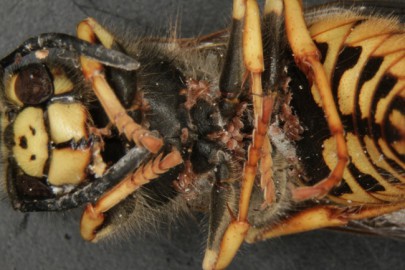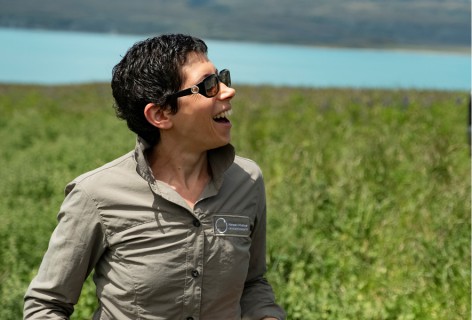Wasp biocontrol update 1
In this section
An update on the project investigating the biocontrol potential of promising-looking mites that were recently discovered and that appear to attack wasps.

Wasp with mite infestation
During the winter of 2014 we began surveying for the recently discovered wasp mite in the Tasman, Marlborough and Nelson Lakes areas. Nik Joice from the Department of Conservation in St Arnaud and Robin van Zoelen from the Tasman District Council examined wasp samples for mites that were sent in to their respective offices. Prior to this survey, the mites had only been found on German wasps in the wild. This survey has already shown that the mites can also be present on common wasps as well as the German wasps. The survey also gives us an indication that the mite is not uncommon on wasps in the upper South Island. While we are still learning about the biology of the mites and the nature of their interaction with the wasps, we now know that the mites can successfully overwinter on the overwintering queen wasps of both introduced wasp species.
It is important to note that the mites have been found at low density in association with beehives. The nature of this association is not yet clear and we will have to make sure the mite is not harmful to valued organisms.
Another aspect of the project we are making progress on is ‘de-newing’ of the mite. The mite is a new organism to science, and has not been recorded yet from anywhere else outside New Zealand. That does not mean it is native to New Zealand. It may be from an overseas origin, and we do not know when it entered New Zealand. Under the Hazardous Substances and New Organisms Act (HSNO 1996), organisms that were not in New Zealand prior to 29/07/1998 are considered new organisms. Such organisms may be allowed entry following consultation and application to the Environmental Protection Authority, EPA. But what if the organism, like our mite, arrived unassisted, not conforming to the regulations? In that case, it is not allowed to propagate and distribute this organism, unless its legal status changes.
While we cannot demonstrate unequivocally that the mite has been here pre 1998, there is compelling circumstantial evidence to suggest that it has. Following consultation with MPI and EPA the Vespula Biocontrol Action Group has now lodged the application to declare the mite species not new to New Zealand. The application will be made open for DOC and MPI to comment on and make enquiries prior to being assessed by a Decision Making Committee.
How does this affect the project?
In the short term, we can continue with the project as planned, because we are not planning any mass rearing and distribution of the mite just yet. We have a lot more to learn about the mite before we can determine if mass rearing and distribution is the way forward. In the long term, if and when we come to the point where we do want to mass rear and distribute the mite, we will only be able to proceed if the legal status of the mite had been successfully changed to ‘not new’. Therefore, it is a good timing now to initiate the legal process, and let us hope that the evidence is sufficient for a Decision Making Committee to determine that the mite is not a new organism. We will keep you informed!


